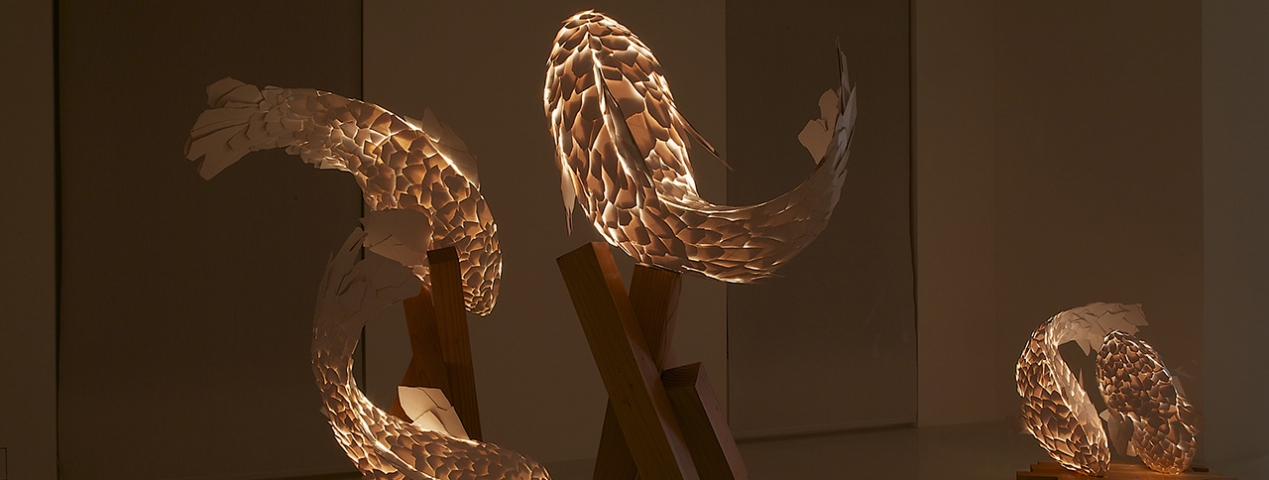One of the most celebrated architects living today, Gehry’s career spans five decades and three continents. Known for his deconstructivist approach and creative use of materials, he has forever altered the urban landscape with spectacular buildings that are conceived as dynamic structures rather than static vessels.
Gehry has always experimented with sculpture and furniture in addition to his architectural pursuits, coaxing inventive forms out of unexpected materials, from the Easy Edges (1969-73) and Experimental Edges (1979-82) -- chairs and tables carved from blocks of industrial corrugated cardboard -- to the Knoll furniture series (1989- 92), fashioned from bentwood. The Fish Lamps evolved from a 1983 commission by the Formica Corporation to create objects from the then-new plastic laminate ColorCore. After accidently shattering a piece of it while working, he was inspired by the resulting shards, which reminded him of fish scales. The Fish Lamps—the first of which were fabricated between 1984 and 1986—employ wire armatures molded into fish shapes, onto which shards of ColorCore are individually glued, creating clear allusions to the physical attributes of real fish.
Ranging in color from white to deep amber, the softly glowing Fish Lamps are full of whimsy. The swell of their bodies, coupled with the nuanced textures of their scaly skin, are a perfect symbiosis of form and function. In the most recent works to join the ongoing series, Untitled (Paris II) (2012), Untitled (Paris III) (2012), and Untitled (Paris VII) (2012), groupings of one, two, and three fish rest on pedestals or dangle from wall mountings. Curling and flexing in attitudes of simulated motion, each fish emits a warm light. Since the creation of the first lamp in 1984, the fish has become a recurrent motif in Gehry’s work, as much for its "good design" as its iconographical and natural attributes. Its quicksilver appeal informs the undulating, curvilinear forms of the Guggenheim Museum in Bilbao, Spain (1997); the Jay Pritzker Pavilion in Chicago (2004); and the Marqués de Riscal Vineyard Hotel in Elciego, Spain (2006) as well as the Fish Sculpture at Vila Olímpica in Barcelona (1989–92) and Standing Glass Fish for the Minneapolis Sculpture Garden (1986).
Frank Gehry was born in Toronto in 1929. He studied architecture at the University of Southern California and urban planning at the Harvard Graduate School of Design. His drawings, models, designs, and sculpture have been exhibited in major museums throughout the world. Among his most celebrated buildings are the Vitra Design Museum in Weil am Rhein, Germany (1989); the Guggenheim Museum in Bilbao, Spain, (1997); and the Walt Disney Concert Hall in Los Angeles (2003). Awards include the Pritzker Architecture Prize (1989); the Wolf Foundation Prize in Arts (1992); the Praemium Imperiale in Architecture from Japan Art Association (1992); the Dorothy and Lillian Gish Prize (1994); the National Medal of Arts (1998); the Gold Medal from the American Institute of Architects (1999); the Gold Medal from the Royal Institute of British Architects (2000); and the Lifetime Achievement Award from Americans for the Arts (2000). “Frank Gehry, Architect,” the most comprehensive exhibition of his work to date, was presented at the Solomon R. Guggenheim Museum in New York in 2001. Gehry’s latest building, the Louis Vuitton Foundation for Creation in the Bois du Boulogne, Paris, will be completed in 2013.
The first Fish Lamps were shown in “Frank Gehry: Unique Lamps” in 1984 at the former Robertson Boulevard location of Gagosian Los Angeles.
Gehry lives and works in Los Angeles.


